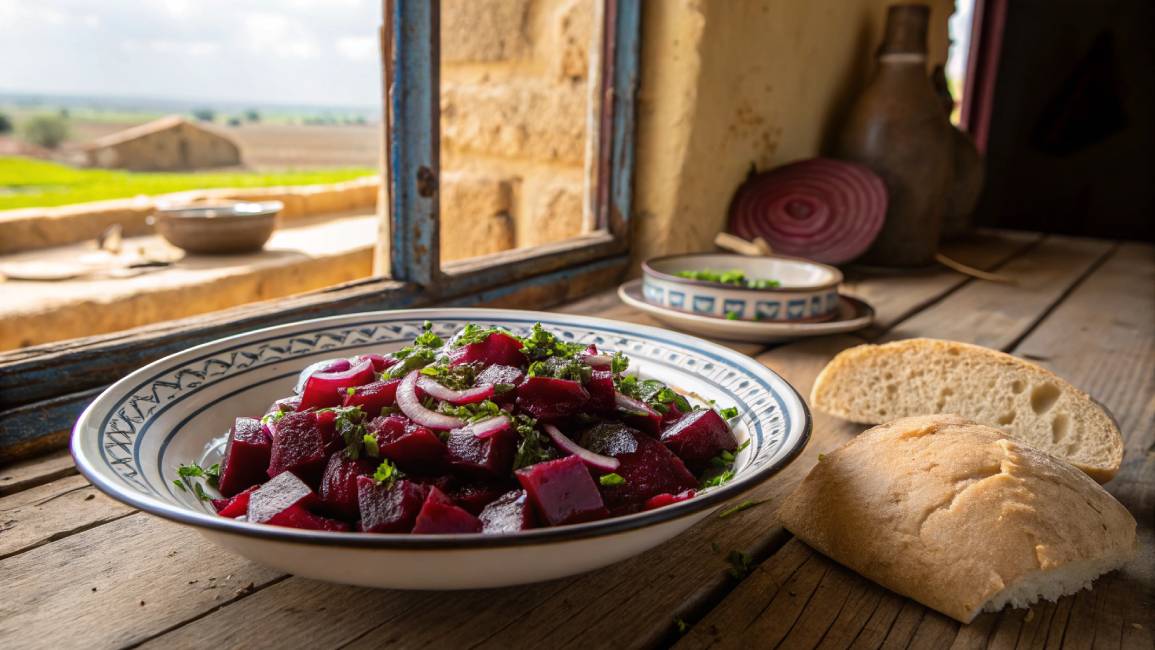Table of Contents
For twenty years, my taxi was more than just a vehicle; it was a symbol of my independence, much like the simple yet flavorful Moroccan Beet Salad I enjoyed along the way. It was my moving office, my dinner table, my front-row seat to life in Morocco.
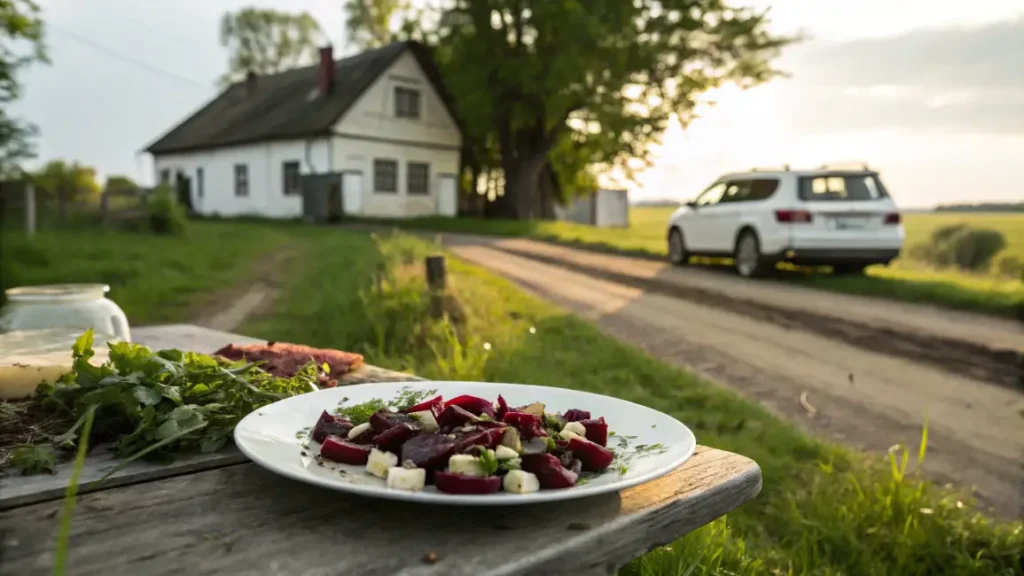
Some of my best meals occurred during pit stops, roadside cafés, family homes, and even the backseat of my cab, parked under dusty olive trees.
One dish followed me everywhere, quietly: beet salad.
The Journey Begins
I didn’t realize it at the time, but I was collecting stories one spoonful at a time. In Marrakech, an elderly vendor added orange zest and whispered, “My grandmother’s secret.” In the Atlas Mountains, a young girl mashed the beets with her hands, saying it made them taste better. (She wasn’t wrong.)
Each version was different, but not random. There was always intention, tradition, memory. That’s what stuck with me.
What you’re about to make isn’t just a side dish. It’s the echo of those meals, a recipe shaped by conversation, shaped by roads.
The Value of Tradition
People sometimes ask what makes Moroccan food so layered. It’s not just the spice, it’s the storytelling. The unspoken rules passed down without recipes. The “you just feel it” measurements. This moroccan beet salad is a perfect example.
In Fès, the salad came with a hint of cinnamon. In Casablanca, it had sharper citrus, almost cheeky. The spices shift from region to region, but the heart of it, warmth, balance, generosity, never changes.
Pair it with our Authentic Moroccan Couscous, and suddenly you’ve recreated a Friday afternoon table somewhere in the Maghreb, complete with laughter and bread tearing and someone always trying to serve you more.
This salad isn’t flashy. It doesn’t need to be. It’s real food with a real soul, shaped by thousands of hands over generations.
Why This Moroccan Beet Salad Might Just Be the Only Recipe You’ll Keep Coming Back To
(Told Through the Eyes of a Taxi Driver Who’s Seen a Lot)
There’s a strange kind of wisdom you gather when your job is driving strangers through Morocco’s back roads, where long silences, half-told stories, and unexpected food memories stick harder than directions ever could.
I never set out to become a beet salad evangelist. Let’s be honest, it sounds too niche, almost laughable. But here we are.
Somewhere between late-night rides in Tangier and sun-drenched tea stops outside Essaouira, this unassuming salad kept showing up. Different every time, but always familiar. And somehow, over the years, it stopped being a side dish… and started becoming a dish. The one I craved. The one I shared. The one I tried to recreate, again and again, until it finally tasted like the road itself.
The Taste of Something Real
What makes it special? It’s the opposite of trendy. No avocado tricks. No foam. Just real, old-school flavor, born from people who measure spices with their palms and trust their instincts over time.
This salad tastes like it’s been somewhere. Like it’s heard in stories. It’s deeply Moroccan, earthy, citrusy, and grounded; every time I make it, It’s as if I’m channeling the wisdom of Moroccan grandmothers, just for a few minutes.
Built for Real Life
You can dress it up with crumbled cheese or leave it bare-bones and still come out a winner. Hot day? Serve it chilled. Cold night? Slightly warm works wonders. It doesn’t pretend to be fancy. It just works, like an old friend who always brings something good, even uninvited
No Fuss, All Flavor
Let’s not overcomplicate this. You don’t need knife skills from culinary school or a spice rack with 40 jars. If you’ve got beets, olive oil, cumin, and maybe a lemon lying around, you’re halfway there. The rest? Just curiosity and a bit of time.
Even if you’re the type who usually skips recipes that require more than 10 minutes of prep, I promise, this one won’t test your patience. It’s forgiving. Almost… cooperative.
And Yeah, It’s Good for You Too
I mean, it’s beets. Of course, they’re packed with nutrients. Iron, fiber, antioxidants, all the usual suspects. But what I care about more is this: it makes me feel good. And not in the “I just ate kale” kind of way, in the “my body and memory are both full” kind of way.
Harvard Health and the Cleveland Clinic can provide you with expert insights into science. But me? I’ll say this: every time I make it, I’m doing something kind for myself without trying too hard.
So yeah, this may not be the most elaborate recipe in your kitchen. But I’d bet it ends up being the one you remember, the one you trust the most. Because sometimes, the dishes that travel the farthest… are the ones that start small and stay honest
The Ingredients That Make It Magic
Not Just a List, More Like a Conversation With the Pantry
When I start pulling things out for this Moroccan beet salad, it doesn’t feel like cooking; it feels like reconnecting with familiar faces.
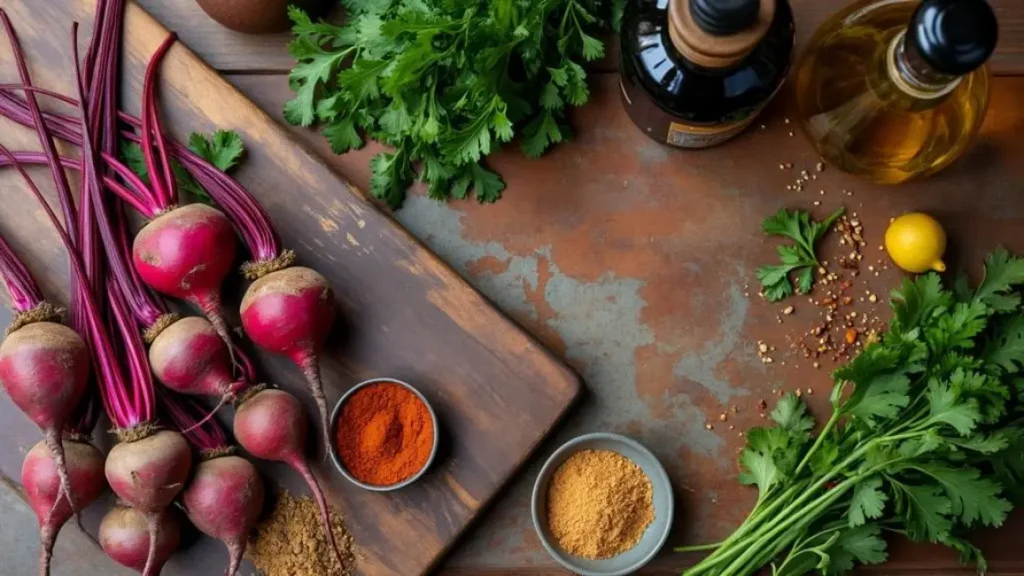
Each ingredient brings its own unique vibe and backstory. And honestly? Half the time, I don’t follow the same steps twice.
Beets, Earthy, Humble, and Full of Surprises
Here’s the thing about beets: they’re not out to impress you. They don’t ask for much, just time, a little patience, maybe a nudge of acid. But if you treat them right, they give you a flavor that’s somehow both grounding and bright.
I used to think beets were… fine. Then I had one in a back-alley café in Meknès, warm, with olive oil and cumin, and it just stuck with me. Ever since, I’ve been chasing that taste.
Red beets are the classic, sure. But if you find golden ones? They’ve got this mellow sweetness, almost like the quiet cousin at the table who ends up telling the best story.
Olive Oil, Morocco’s Liquid Warmth
Moroccan olive oil doesn’t whisper. It talks back. It’s green, bold, peppery, like it knows exactly what it’s doing. One pour and suddenly the whole dish shifts.
Do you need the fancy stuff? Not really. But if you ever grab a bottle from a roadside vendor in the Rif, you’ll see what I mean. It tastes… alive.
Spices, Not Just Flavor, But Feeling
Cumin is the first scent you’ll catch when something’s cooking in a Moroccan home. It’s warm, grounding, a bit like being wrapped in a wool blanket that still smells faintly of firewood.
A touch of paprika gives it color and that almost unnoticeable heat. Some days, I’ll toast the cumin seeds first; other times, I’m too hungry to bother. Both work. That’s the beauty of it.
Herbs, The Quiet Heroes
Fresh parsley and coriander don’t shout. They nudge. They brighten everything without seeking recognition.
I chop them roughly. No rules. No fuss. Just enough to let their flavor peek through when you’re not expecting it. Once in a while, I’ll throw in a few mint leaves if I want that extra lift, especially in summer.
Acid, The One You Choose Last
Lemon or vinegar? Depends on the day. Lemon brings out the sunshine. Vinegar adds a bit of attitude. There’s no wrong answer, just different moods.
Some recipes swear by one or the other. Try both and see which one your version of the salad prefers. It always finds a way to let you know.
These ingredients? They’re not just building blocks. They’re memories in disguise. Put them together, and it’s not just salad on the table, it’s a little story you get to eat.
How to Cook Beets Perfectly, Honestly, It’s Easier Than It Sounds
Let’s be real: beets can be intimidating. They bleed, they stain, they take time. But once you find your groove, they sort of… fall into place. It’s simply about choosing the method that suits your day, not what sounds impressive.
I’ve cooked them all sorts of ways, depending on whether I was feeling patient, lazy, or somewhere in between.
Method 1: Roasting, Deep Flavor, Deeper Satisfaction
If you’ve got time, roast them. No question. It’s the one method where beets go from “meh” to “okay wow.”
I usually set the oven to 400°F (205°C), wrap each beet like a present in foil, and toss them on a tray. They hang out for about 45 minutes, sometimes longer, depending on size and whether I remembered to preheat the oven.
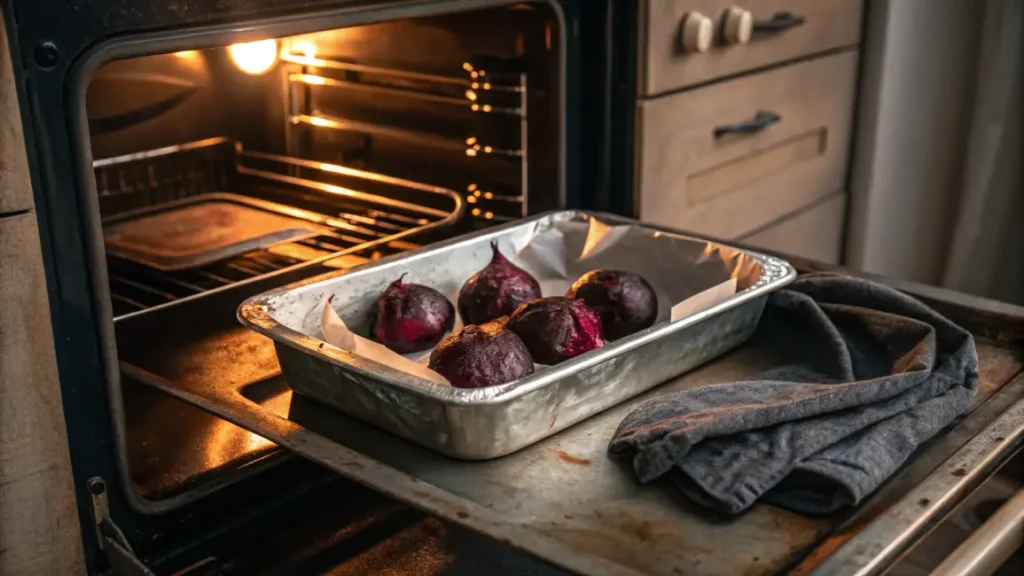
When a fork slips in easily, they’re done. Let them cool a bit, and the skins rub right off. Bonus: your kitchen will smell like you know what you’re doing.
If you want extra technique tips, Epicurious has you covered.
Method 2: Steaming, When You Just Want Something Clean and Simple
Steaming is my fallback. It’s quicker, and it keeps the color crazy bright, like they’ve just come from the market.
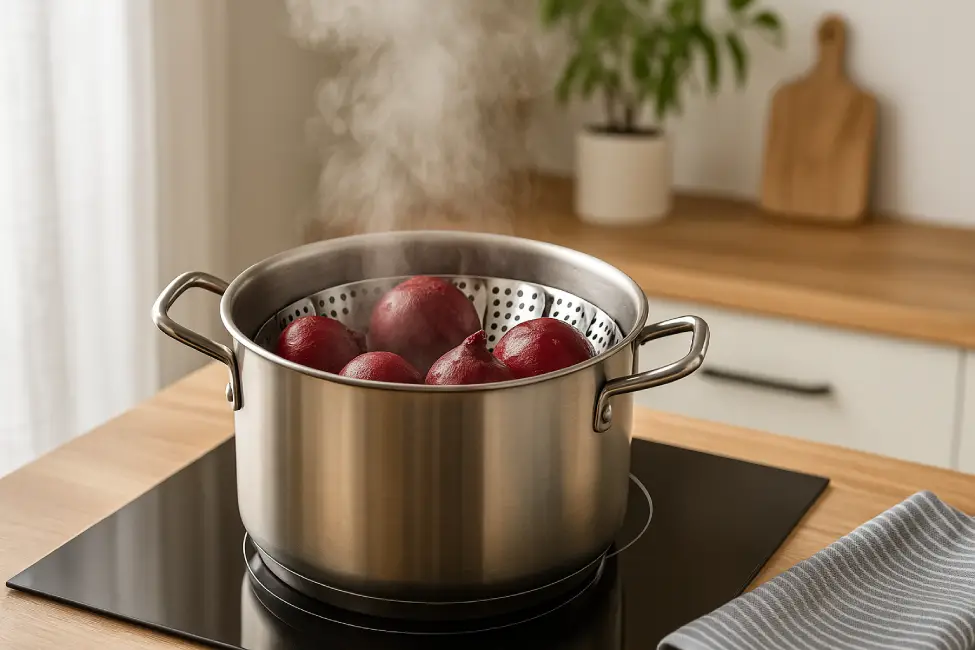
I place them in a steamer basket over simmering water, cover the pot, and let them cook for about 30–40 minutes. That’s it. No drama.
The texture stays soft without being mushy, and the taste? Pure beet. No caramelization, no flash. Just clean, quiet flavor. Works great when paired with something bold, like our Moroccan Couscous.
Method 3: Instant Pot, For the “I Forgot Dinner” Nights
I resisted the Instant Pot for a while, until I had a week where I lived on nothing but toast and excuses.

Now? It’s my get-it-done machine.
Place a cup of water in the pot, set the beets on the trivet, seal the lid, and pressure cook for 15–20 minutes, depending on the size of the beets. I let the pressure release naturally (or until I remembered I was cooking), and boom, it was done.
Not gourmet, but solid. Reliable. Like an old friend who doesn’t ask too many questions.
Method 4: Pre-Cooked, No Shame, Just Beets
Look, sometimes the best cooking is… not cooking.
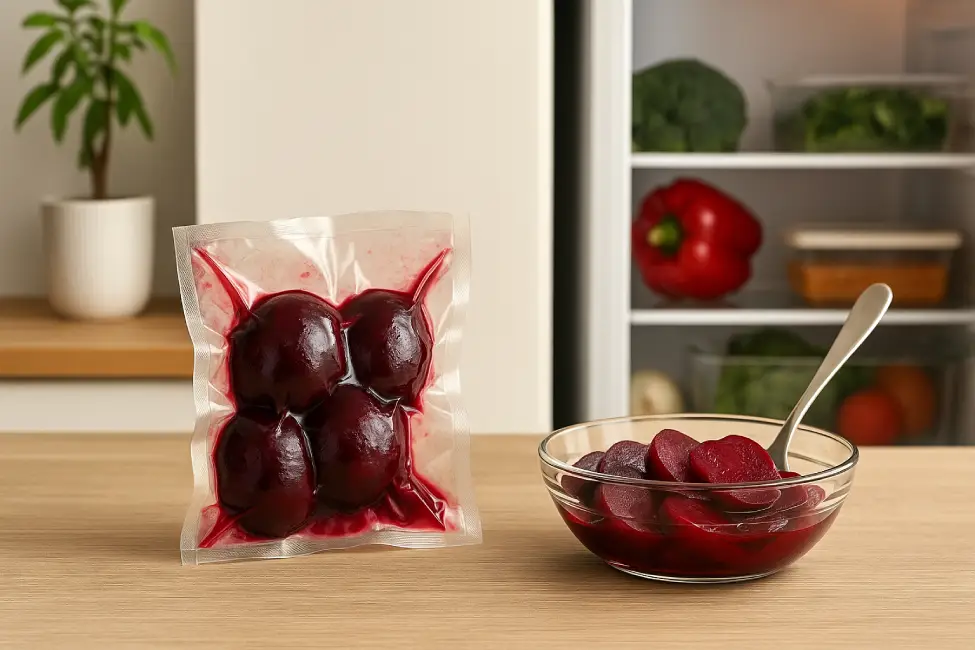
Pre-cooked, vacuum-packed beets aren’t fancy. But they’re there when you need them, sliced into salads, tossed with vinegar, or eaten straight out of the bag when you’re standing in front of the fridge. We’ve all been there.
They’re not roasted deeply, but they’re not flavorless either. Call it the survival mode method. Nothing wrong with that.
Quick Look: What Each Method Brings to the Table
Method Time Flavor Good For
1 Roasting 45–60 min Sweet, rich Slow days, dinner parties
2 Steaming 30–40 min Mild, clean Light meals, meal prep
3 Instant Pot 15–20 min Quick, soft Midweek sanity
4 Pre-Cooked 5 min Ready now Busy nights, lazy lunches
So yeah, there’s no “right” way here. Just the one that fits. Some days you want the whole roast experience, other days you want beets with zero effort. Either way, they deliver.
And if you’re looking to level up, try them next to our Beef Tagine with Artichokes & Fava Beans. That combo? Total comfort.
How I Make Moroccan Beet Salad (The Real-Life Version)
Beets can be a diva. They stain everything, take forever to cook, and don’t smell like a bakery while they’re cooking. But still, once you figure them out, they become something you crave more than you expect.
This is how I typically assemble this salad. No fluff. Just honest steps.
Step 1: Cook the Beets (Yes, It Takes a While, but It’s Still Worth It.)
Start with the obvious, the beets.
Roasting? Amazing, but some days, I don’t have the patience. Boiling works just fine, especially if I’m multitasking or, let’s be honest, just hungry.
Here’s my go-to boil method:
- Toss your beets into a saucepan with water. Add a slice of lemon, not for show; it actually enhances the color and adds a subtle kick of brightness.
- Lid on, heat to medium-high. Let it roll gently for about an hour if they’re big. Smaller ones? Check at 40 minutes. They should feel fork-tender.
- Once they’re done, let them cool slightly, then gently rub off the skins with your hands or a paper towel. (It’s weirdly satisfying.)
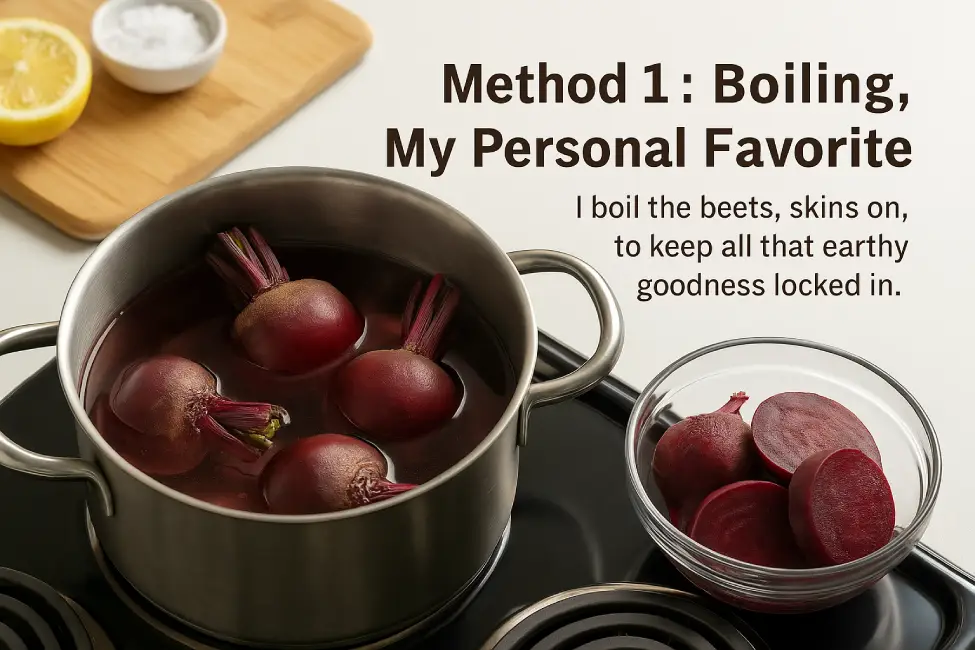
👉 Want to see how someone else does it? I stumbled on this YouTube video by Aliyah that shows a super simple version of Moroccan beet salad. It’s not from us, full credit to her, but it’s a nice visual if you like watching stuff before cooking.
Step 2: Make the Charmoula-ish Dressing (aka the Magic Part)
While the beets are doing their thing, you can throw the dressing together. This is where the flavor really happens.
No strict rules here:
- Pour in a generous amount of olive oil, squeeze in some lemon juice, and add cumin (you’ll need it), along with a sprinkle of paprika if you’re feeling adventurous.
- Garlic, crushed or mashed, is best when it is fresh.
- Then, lots of parsley and cilantro. Don’t skimp. Rough chop is fine.
Mix it all. Taste it. Then adjust. A little more lemon? Go for it. Missing something? Maybe a pinch of salt. Trust your tongue.
BTW, this dressing? Same base as the one in our Zesty Moroccan Whiting Fish Recipe. Works wonders there too.
Step 3: Put It All Together, Then Let It Sit (Yes, Really Sit)
Once the beets are cool, slice or cube them as desired.
- Pour the charmoula over, stir gently. You’re not tossing a salad here, you’re introducing flavors. Let them meet slowly.
- Then, and this is important, let the whole thing sit. At least 30 minutes. More if you can wait.
That’s when the magic happens. The beets soak it all in, and suddenly you’re not just eating vegetables; you’re experiencing something more. You’re tasting something layered, deeper.
It’s a simple dish, but it tells a story.
A quiet one, about patience, spice, and the way flavors shift when they’re given time.
Not perfect? That’s fine. That’s how real food works. And this one? Forgiving, easy to love, and always welcome on the table.
From My Travels: Local Twists I’ve Come to Love
What I’ve always loved about Moroccan cuisine is how it never pretends to be one thing. It shifts, from city to mountain, from coast to desert, always holding the same soul, but showing a different face.
Even something as simple as beet salad? It changes. A lot. And honestly, that’s part of the fun.
Fes: Where It Gets Warm and a Little Mysterious
Picture this: walking through the tangled alleyways of Fes, the scent of bread baking and spices floating past open windows. I once had a beet salad there that caught me completely off guard, cinnamon and raw onion, mixed in as if they had always belonged.
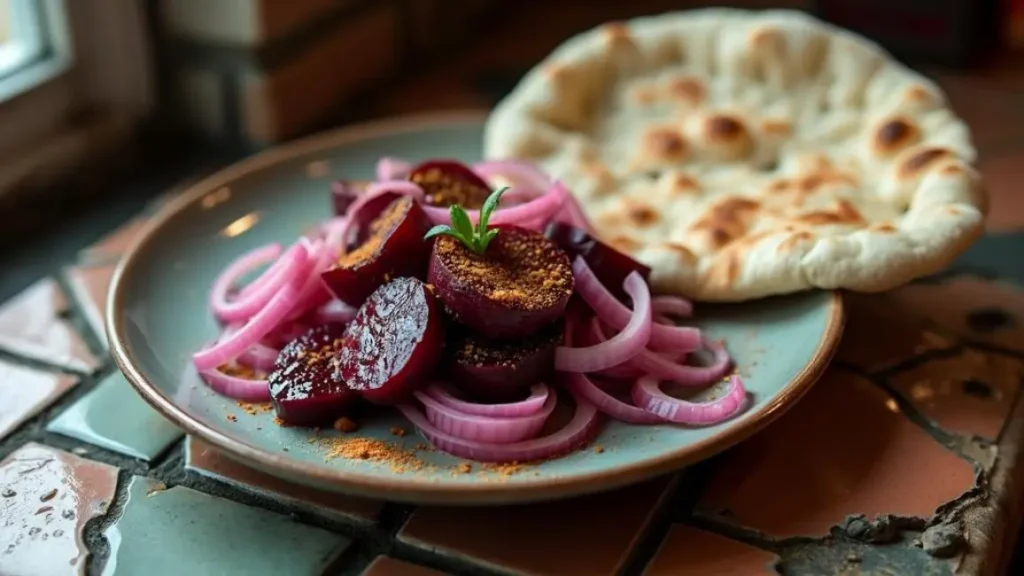
It shouldn’t work. But it does. The cinnamon adds this quiet warmth that sneaks up behind the beet’s earthiness. Not sweet-sweet, more like… the warmth of a room after someone’s been laughing in it.
I still think about that plate.
Marrakech: Bright, Bold, and a Bit Flirty
Then there’s Marrakech. Loud, colorful, alive in every sense. Even the food carries that vibe. One vendor added a whisper of orange zest to the beet salad. Citrus and beet? I had doubts.
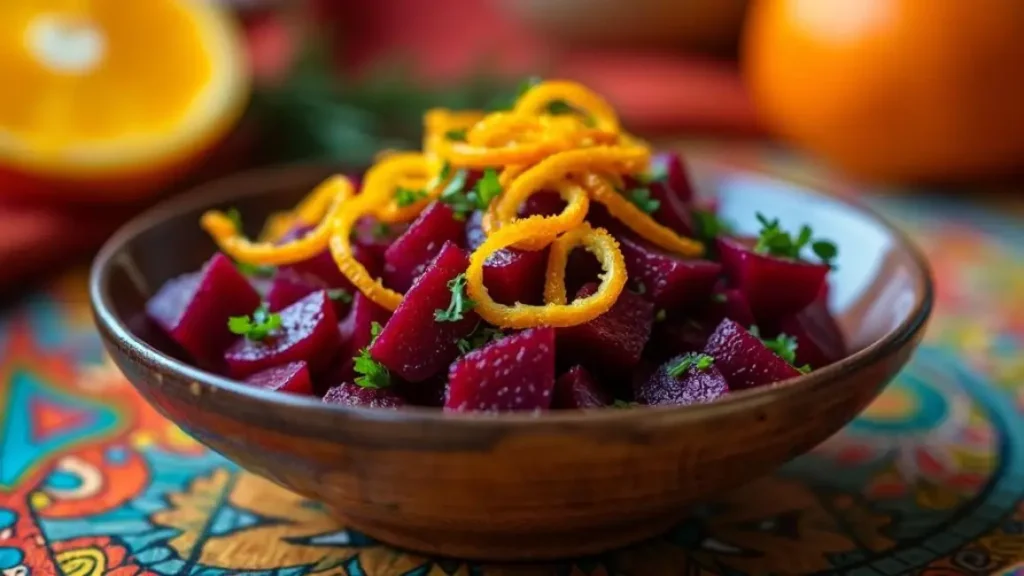
One bite in and I didn’t care. It was playful, sunny, and made the whole dish feel lighter. Not in a “diet” way, in a dancing-in-the-market kind of way.
Now and Then: The Modern Tweak
Tradition is great. But sometimes, you want to mess with it, just a little. I’ve seen (and tried) versions with crumbled feta, toasted walnuts, even a drizzle of pomegranate molasses once. Some purists might roll their eyes… but hey, it worked.
Those little upgrades don’t erase the original, they just dress it up differently, like putting on a new jacket over the same beloved sweater.
And if you’re going full-flavor? This salad, with a few modern touches, paired with our Lamb Tagine with Sweet Onions… that’s a table worth sitting at.
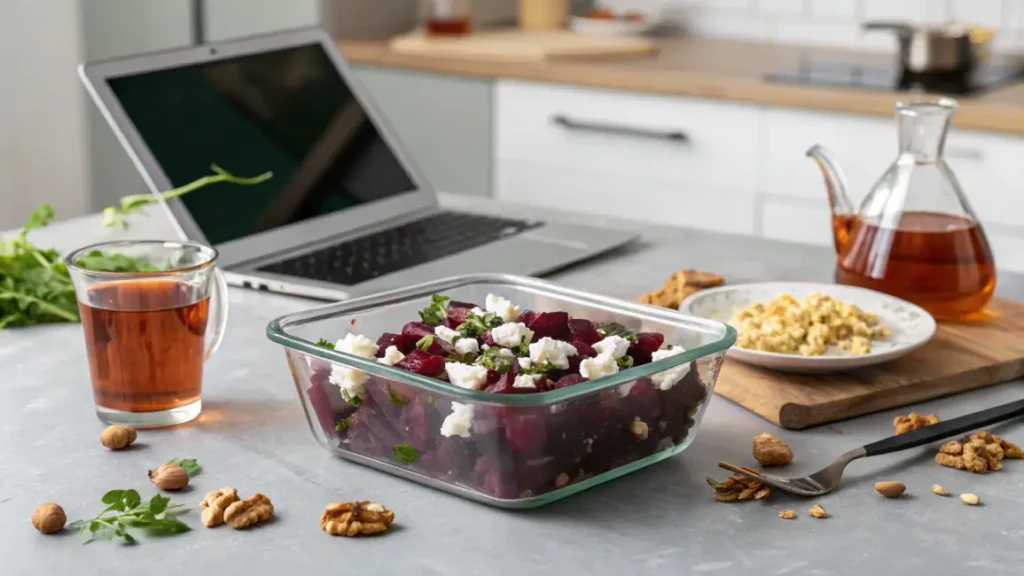
Every version of this salad, whether it’s seasoned by cinnamon air in Fes, kissed with zest in Marrakech, or fancied up for today’s tables, tells a story. It’s still beets. Still honest. Just… told through different voices.
How I Serve & Store It (A Few Things I’ve Learned)
This salad’s the kind of dish that plays nice with whatever’s going on in your kitchen. It doesn’t beg for attention, but it always earns a spot on the table, and yeah, it somehow tastes better the next day. Let’s break it down the way I usually explain it to friends who ask for the recipe.
Serving. It’s Flexible, Honestly
Warm or chilled? I’ve done both. It depends on the season and my mood.
Cold from the fridge, it’s perfect next to something like grilled chicken.
The sweetness of the beets against charred meat? So satisfying. But if you’re leaning Moroccan, pair it with something big and slow-cooked. I like it with our Ultimate Moroccan Beef Tagine. The briny lemons, the olives… then this bright little salad on the side? It all just works.
And don’t forget seafood. This salad next to a flaky white fish? Looks great. Tastes better. Especially when you need something that feels fresh without being fussy.
No rules here. Just good pairings. Follow your craving.
Storing. Actually Gets Better with Time
Here’s something I learned the hard way: don’t toss the leftovers. This salad improves after being refrigerated overnight. The charmoula settles in, the beets soak it up, the whole thing feels deeper, rounder the next day.
Store it in an airtight container. Three days is usually the sweet spot. After that, it doesn’t go bad, but it starts losing its voice, if that makes sense.
Before serving again, give it a gentle stir. Perhaps a squeeze of lemon or a drizzle of olive oil if it’s a bit dry. However, it often doesn’t require much. Just a fork and a quiet moment.
Oh, and if you’re into smart food storage stuff, BBC Good Food has great tips. I don’t follow them all, but they’ve saved a salad or two of mine.
Serving and storing might sound like afterthoughts, but honestly? That’s where a lot of the magic hides. Whether it’s your first bite or the leftovers at midnight, this salad shows up, no drama, just real flavor.
Common Moroccan Beet Salad Questions (Straight from the Field)
Let’s be honest, even simple recipes throw curveballs sometimes. Whether it’s your first time making this salad or your tenth, stuff happens. Here’s what I’ve heard (and said) over the years, and what’s worked for me.
“My salad came out too watery. Did I mess it up?”
Nope, it happens. Beets hold a lot more water than people expect, especially if they’re steamed or boiled.
What do I do? I just drain off the extra liquid. A fine strainer does the trick. If it still feels a bit soggy, add a handful of fresh herbs or even chop up another beet if you’ve got one. Stir gently. It usually bounces back.
“Can I use canned beets, or is that cheating?”
Not cheating at all. I’ve used canned beets more times than I can count, especially on busy nights.
Just rinse them well. Like, really well. Get rid of that briny taste, and you’ll be fine. They won’t have the same depth as roasted, but the salad still works. Some nights, convenience wins. And that’s okay.
“Why do my beets taste… earthy? Almost too earthy?”
Ah, the famous “dirt flavor.”
It usually means they weren’t scrubbed clean before cooking. Beets grow underground, so yeah, they bring the earth with them.
Give them a solid scrub under running water first. Then peel after cooking (skins slide off easily when they’re warm). That usually clears up the taste.
Unless you like that earthy note, in which case, power to you.
“Can I freeze it?”
Mmm… I wouldn’t. The salad gets mushy, and the charmoula loses its punch.
If you really need to freeze something, freeze the cooked beets alone, without any dressing or herbs. Then mix it fresh when you’re ready to eat. But honestly? It’s better just to eat it over a couple of days. It actually gets better in the fridge anyway.
If you’ve got another question or something weird happens with your batch, just ask. Chances are, someone has dealt with it before or winged it and made something even better.
Closing Thoughts. Nothing Fancy, Just Real Food
That’s it. That’s the salad.
Nothing wild. No secret trick. Just a bunch of beets, some good olive oil, a few pinches of spice, and the patience to let it all come together.
If you’ve made it this far, thanks. Really. I never thought I’d write this much about beets, but here we are. They’ve followed me across cities, conversations, and kitchens. Feels right to pass that along.
If You’re Gonna Make It…
Don’t stress the steps. Cook the beets your way. Make the dressing bold or mellow. Eat it warm, cold, alone, or with a crowd.
And if you do make it? Let me know.
Seriously. I’d love to hear how yours turned out, or what you added, changed, forgot. That’s how food works. It travels. Evolves. Sometimes improves.
If this one hit the right note, I’ve got more. Fish dishes, couscous, slow-cooked tagines with preserved lemon… all waiting in the wings. Same spirit, different flavors.
Anyway, thanks for hanging out in my kitchen, even if just on screen.
Let Morocco meet you where you are. One bite at a time.
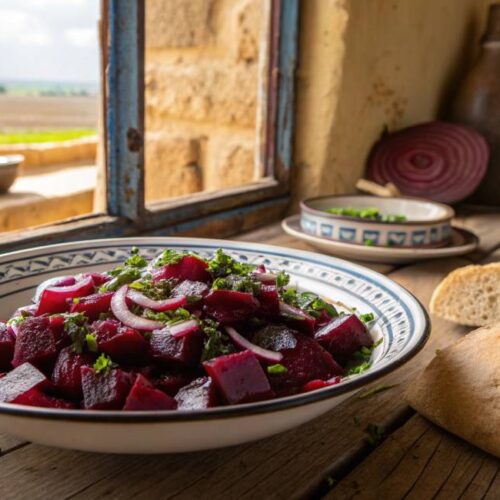
Authentic Moroccan Beet Salad: More Than Just a Salad, It’s a Journey
Ingredients
Ingredients:
- 3 beetroots approximately 2 lbs
- – 1 small onion grated
- – 1/3 cup finely chopped parsley
- – 2 tablespoons olive oil
- – 1 tablespoon vinegar or lemon juice
- – Salt to taste
- – Pepper to taste
- – Cumin to taste
Instructions
Instructions:
- Fill a saucepan with water and place the beetroots in the water. Optionally, add half a lemon slice to enhance color and flavor.
- Cover the pan and set the heat to medium-high. Let the beetroots cook in boiling water until done, about 1 hour for large beetroots. For smaller beetroots, adjust the cooking time accordingly.
- Check the beetroots by using a fork; you should be able to pierce them easily, and the skin should peel off with ease.
- Drain the beetroots from the boiling water and place them in a large bowl with cold water to cool them off.
- Mix together the grated onion, olive oil, chopped parsley, vinegar, salt, pepper, and cumin in a separate bowl.
- Once the beetroots have cooled down, peel them and slice them. To avoid staining, cover your cutting board with paper.
- Mix the parsley and onion mixture into the sliced beetroots.
- Taste the beetroot salad and adjust the spices to taste, adding more salt, cumin, or pepper as needed.
- Cover the bowl with plastic wrap and place the beetroot salad in the fridge for a few hours before serving.
- Serve the beetroot salad cold. It can be enjoyed with or without bread. If the beetroots are too strong for your taste, toss the salad with spinach and lettuce.
Notes
- Beetroot is a versatile vegetable and can be boiled, steamed, or roasted. It is rich in flavor and nutrients.
- Make sure to wash your hands immediately with water and soap after handling beetroot to avoid staining.
Nutrition Information (per serving):
| Nutrient | Amount |
|---|---|
| Calories | 150 |
| Total Fat | 9g |
| Saturated Fat | 1.5g |
| Cholesterol | 0mg |
| Sodium | 150mg |
| Total Carbohydrate | 16g |
| Dietary Fiber | 4g |
| Sugars | 11g |
| Protein | 2g |
Note: Nutritional values are estimates based on standard ingredients and may vary depending on optional additions like raisins, nuts, or honey. Values are calculated per serving (1 of 4). This salad is naturally vegan and gluten-free.
Glossary of Moroccan Culinary Terms for Readers
| Word/Expression | Explanation |
|---|---|
| Beetroot | Often simply called “beets” in the US. |
| Charmoula | A North African marinade or sauce made with herbs, spices, and lemon. |
| Couscous | A type of wheat semolina, commonly served with North African dishes. |
| Tagine | A traditional Moroccan dish cooked in a conical clay pot. |
| Harira | A Moroccan soup often consumed during Ramadan. |
| Fes/Marrakech | Famous Moroccan cities known for their cuisine and culture. |
| Ras el hanout | A Moroccan spice blend often used in tagines. |
| Preserved lemon | Lemons that have been pickled, commonly used in Moroccan cooking. |
Join Our Culinary Journey on Social Media
Dive deeper into the vibrant flavors of Moroccan cuisine by joining us on social media! Connect with fellow food enthusiasts, share your own culinary creations, and get inspired by drool-worthy recipes and exclusive tips.
Whether you’re a seasoned home cook or just starting your Moroccan food adventure, our community is the perfect place to explore, learn, and celebrate the rich traditions of Moroccan cooking.
Follow us today and be part of our flavorful journey, your taste buds will thank you!
Use the hashtag #TajineRecipes when you share your dish, we might feature you next! ✨
Stay in the Loop with Our Moroccan Delights Newsletter
Unlock the secrets of Moroccan cuisine by subscribing to our newsletter! Get exclusive recipes, cooking tips, and behind-the-scenes stories delivered straight to your inbox. Whether you’re looking to recreate traditional dishes or explore modern twists, our newsletter is your passport to the rich and diverse world of Moroccan flavors. Don’t miss out, join our community of food lovers today and start your culinary adventure!
📩 Join Our Moroccan Foodie Community
Get the best Moroccan tagine recipes and seasonal culinary tips straight to your inbox.
We Want to Hear From You!
Your feedback is the spice that enhances our content! Share your thoughts, questions, and culinary adventures in the comments section below.
Whether you’ve tried one of our recipes, have a tip to share, or just want to say hi, we’d love to hear your voice.
Let’s create a vibrant community where Moroccan cuisine is celebrated and enjoyed by all. Comment now and join the conversation!
